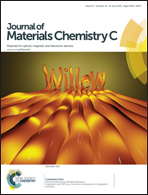Red emissive organic light-emitting diodes based on codeposited inexpensive CuI complexes†
Abstract
Inexpensive materials made of abundant natural resources such as CuI complexes are essential to sustain the development of organic light emitting diode (OLED) technology for mass market applications such as solid-state illumination. CuI complexes, however, mostly are neither soluble nor stable toward sublimation, which is a road block for the development of efficient CuI complex based OLEDs using traditional methods of synthesis, sublimation and vacuum evaporation. In this work, two isoquinolyl carbazole (CIQ) compounds 9-(8-(carbazol-9-yl)isoquinolin-5-yl)-carbazole (DCIQ) and 9-(4-(5-(4-(carbazol-9-yl)phenyl)isoquinolin-8-yl)phenyl)-carbazole (DCDPIQ) were synthesized to codeposition with copper iodide (CuI) to form red emissive dimeric CuI complex doped film in situ, which could be utilized directly as the emissive layer (EML) in OLEDs. After a systematic study of the two compounds and their codeposited CuI : CIQ films, as well as optimizing the CuI doping concentration, it is found that red OLEDs can be achieved, showing a maximum emission band, an external quantum efficiency (EQE), a luminance of 643 nm, 3.5%, 3290 cd m−2 for DCIQ, and 635 nm, 3.6%, 853 cd m−2 for DCDPIQ, respectively.


 Please wait while we load your content...
Please wait while we load your content...